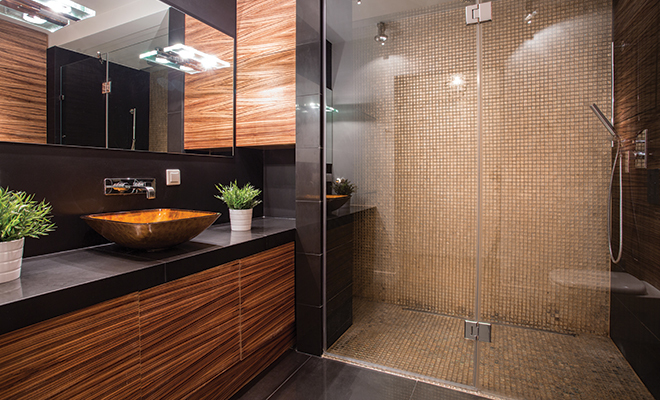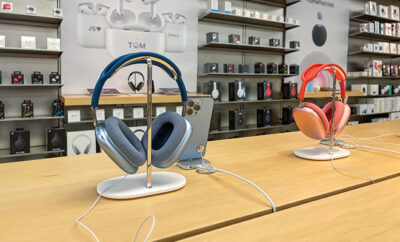
Tile and stone trends
It’s spring, time to visit the home and garden shows and homebuilders’ showcases to collect ideas for your new home or upcoming remodeling project. The trends in tile and stone for the coming year are exciting and, in some areas, a radical departure from what you may think!
As designers and architects transition commercial looks into home design, a trend that has developed in Europe is sparking a new look throughout the home. Large format tiles and thin porcelain tiles, ranging in size from 39” by 39” square to 39” by 120”, give a sleek look to walls, floors and countertops in a dizzying array of colors and patterns that simulate concrete, marble and granite. For example, the Laminam thin porcelain tiles, at 3mm in thickness (or rather thin-ness!) are the largest and thinnest porcelain panels in production, according to Crossville®, manufactured with a revolutionary process that creates a flat panel that can be trimmed with exceptional accuracy.
At Cersaie 2015 in Bologna, Italy, stand-out looks included brick shapes, from micro to macro, with interpretations of old brick walls and brick with mortar spills to painted brick and mortar. Chevron and herringbone patterns across all scales were represented, and several manufacturers presented ceramic tiles with three-dimensional folds, wavy ridges and wavy ridges that fitted together create a seamless sculpted surface.
Imola Ceramica’s Kuni full-body porcelain stoneware captures the look of wood, complete with knots and ridges, in the large-format 24” by 70” tiles as well as smaller planks in colors ranging from almond to dark brown, grey and white. These are not quite as slim, with the thinnest at 5mm, yet the press technology that creates full-body porcelain yields a tile with low porosity, a water absorption rate of less than .1 percent. These tiles exhibit superior wear resistance; the surface color extends all the way through the tile body, so that if a tile is chipped, the damage is minimal.
High Definition Porcelain technology, or HDP, uses high-speed printers to give realism to the surface decoration of tiles. Three-dimensional printing techniques add veining and metallics, as well as textures and graphics in subtle patterns. Printers up to 1,000 dpi create glaze patterns replicating wood and stone patterns that are indistinguishable from the natural materials and ultimately more durable. American manufacturer Florida Tile reproduces the sophisticated look of Vermont slate with its Cliffside line. EarthstoneHDP features four earthy tones reminiscent of a hand-hewn stone block. Tides interprets limestone and travertine, with veining that adds color and interest. All are manufactured in the USA with 40 percent post-industrial recycled content.
As we discuss the trends and newest products for our walls and floors, it’s necessary to mention a key–and new–component of consumer home safety, new standards of slip resistance for floor tile. The coefficient of friction, or COF, describes the force required for one surface to begin sliding over another. For most of us, that means how quickly a shoe sole will slip on a wet surface. A new measurement, the DCOF AcuTest, is now a world-wide standard and will be used by a tile manufacturer in its specifications. As a consumer, you should look for a minimum threshold of 0.42 DCOF, dynamic coefficient of friction. This means that floor tile that may be walked on when wet should have a DCOF value of .42 or higher. Ask your designer or supply house about this specification, intended to reduce the risk of slips and falls in home installations.
Would you like to have an upscale installation of tile or stone in which the grout becomes almost invisible because it matches your paint color exactly? Creating a huge buzz in both the design and tile worlds is the introduction of AnyColor™ grout in the PermaColor® Select line by American manufacturer LATICRETE. This revolutionary system creates an almost endless spectrum of grout colors for the homeowner. Select a paint color from either the Benjamin Moore® or Sherwin-Williams® paint palette, provide the paint number to your distributor, and the custom grout color will be project ready in two weeks.
Antimicrobial coatings aren’t new, but they’re becoming a trend as they are being incorporated in the tiles themselves. Microban®, an international leader of built-in antimicrobial technology, has partnered with American manufacturers Daltile and American Olean, among others, to infuse Microban’s antimicrobial coating into the tile glaze during the manufacturing process. Thus it becomes a permanent part of the glaze, working continuously for long-lasting antimicrobial protection that keeps the tile surface clean longer.
As you plan vision boards, draw up blueprints and hire a contractor, keep a couple of things in mind. Carefully review the spec sheets of the products you choose for durability and DCOF. Plus, new technology and new materials require new skills in installation. The large-unit tiles require extremely plane and flat substrates, and thus the installers should have special training. The Ceramic Tile Education Foundation is a great resource for information about the correct installation of these beautiful, trendy materials. HLM
Sources: crossville.com, imolaceramica.com, floorcoveringweekly.com, interiorsandsources.com, laticrete.com, microban.com, tile-assn.com and tilecareer.com.







